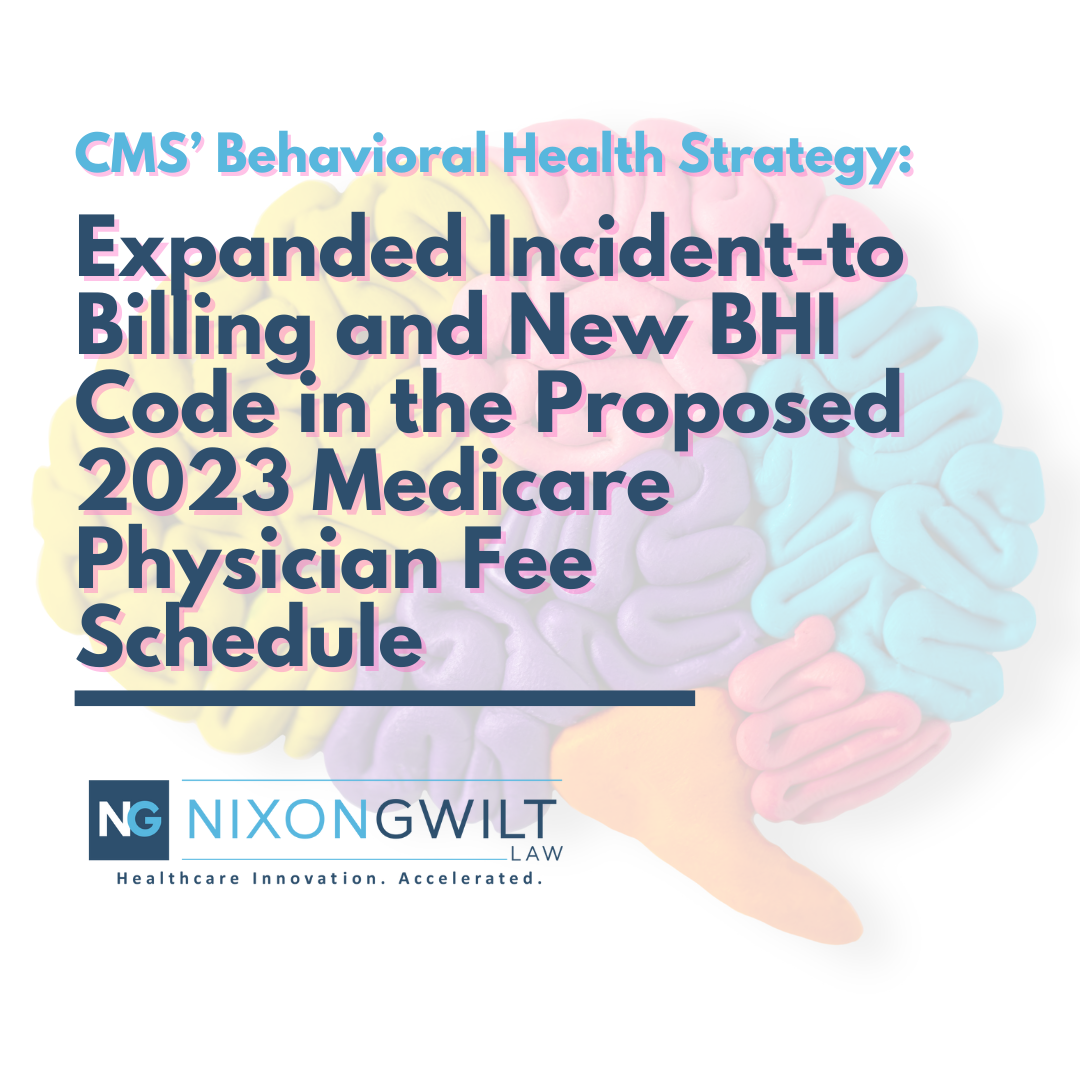Under the Proposed Rule, physicians and non-physician practitioners – for example, nurse practitioners (NPs) and physician assistants (PAs) – can order and bill for APCM services. Here’s what digital healthcare innovators need to know.
Read MoreDiscover what the OIG found when investigating telehealth billing fraud, what they recommend regarding future CMS oversight, and four takeaways for businesses billing Medicare telehealth services.
Read MoreImplementation of CMS’ Behavioral Health Strategy in 2023: Behavioral Health Integration G-code for Clinical Psychologists and Clinical Social Workers, and Opportunity for Clinical Staff to Provide Behavioral Health Services under General Supervision of Physicians and Non-Physician Practitioners
On Monday, August 3, 2020, the Centers for Medicare & Medicaid Services (“CMS”) released the 2021 Medicare Physician Fee Schedule Proposed Rule (the “2021 Proposed Rule”). In the healthcare industry, the Medicare Physician Fee Schedule or “MPFS” is arguably the most prominent force shaping the industry on an ongoing basis. Each year, CMS releases a Proposed Rule mid-summer to give stakeholders a first look at what is potentially to come for the following year. Stakeholders have an opportunity to comment on those proposals, CMS reads the comments it receives, and then based on those comments CMS updates its proposals and releases a Final Rule.
Read MoreThe Center for Medicare and Medicaid Services (“CMS”) has issued a second Interim Final Rule (“IFR2”) that includes additional expansions and clarifications relating to the provision and reimbursement of telehealth, remote patient monitoring, and telephone services during the COVID-19 Public Health Emergency (“PHE”). While these expansions are another step forward for the adoption of digital technologies and services in healthcare, there are additional changes needed in the near-term, as detailed in the summary below.
Read MoreMedical providers across the spectrum have endured a significant hit to revenues as a result of the COVID-19 public health emergency (PHE). MGMA’s recent report, “COVID-19 Financial Impoact on Medical Practices”, indicates that nearly 100% of providers have seen a negative revenue impact, with an average decrease in revenue of 55%. To offset some of those losses, the CARES Act allocated a $50 billion “general allocation” to support the sustainability of these providers.
Read MoreOn January 21, 2020, the Centers for Medicare and Medicaid Services (CMS) finalized a decision (under National Coverage Determination (NCD) 30.3.3) to cover acupuncture for Medicare patients, specifically those with chronic low back pain (cLBP).
Read MoreIn this article on the proposed changes to the fraud and abuse regulations, we focus on OIG’s proposed Patient Engagement and Support safe harbor to AKS and CMP and discuss how this new safe harbor may affect care management services vendors such as Chronic Care Management (CCM), Remote Patient Monitoring (RPM), Transitional Care Management (TCM), and Behavioral Health Integration (BHI) services vendors.
Read MoreThe Centers for Medicare and Medicaid Services (CMS) released the Final Medicare Physician Fee Schedule for CY 2020 (the “2020 MPFS”) on November 1, 2019, finalizing some important changes relating to Remote Patient Monitoring (RPM) services, but leaving many questions unanswered as of yet.
Read MoreWhen developing new medical device and drug products, it is important to understand how the product will be adopted and paid for in the marketplace. The development of new drugs and devices involves countless hours researching, testing, modifying, iterating, and testing some more… In larger companies, whole teams of people also dedicate the same effort into developing a market access plan—meaning careful planning for manufacturing, distribution, and insurance contracting. This strategic planning can be overlooked in start-up biotech companies operating on limited resources and which are squarely focused on innovating new technologies.
Read MoreHospitals and medical device manufacturers will both benefit from the Centers for Medicare and Medicaid Services’ (CMS) finalization of the 2020 Inpatient Prospective Payment System (IPPS) Final Rule (“Final Rule”) scheduled to be published on August 16, 2019. In an effort to increase Medicare beneficiaries’ access to innovative medical technologies, CMS has finalized certain changes to the “new technology add-on payment” “(NTAP) application and payment processes under the Final Rule. This change is likely to encourage hospital adoption of new technologies, which is intended to spur innovation and additional investment in these technologies.
Read MoreIn April, the U.S. Department of Health and Human Services (HHS) and the Centers for Medicare and Medicaid Services (CMS) announced a new set of payment models meant to allow primary care providers deliver better care at a lower cost to their patients by removing unneccessary administrative and adjust payouts from procedures to outcomes.
Read MoreRemote patient monitoring providers have known the benefits of RPM, including better outcomes for patients and lower overall cost of care, for awhile now. But with innovations in technology and CMS’ move to allow separate reimbursement for RPM bring incredible opportunities for health care technology companies and providers alike. Read more on Digital Health Today.
Read MoreOn March 14, 2019, CMS issued “Technical Corrections” to address errors in the 2019 Final Medicare Physician Fee Schedule (“MPFS”) published on November 23, 2018. One of these corrections addresses “incident to” billing by clinical staff, and has important implications for Remote Patient Monitoring under CPT Code 99457.
Read MoreThe final 2019 Medicare Physician Fee Schedule (the “Rule”), released on November 1st, creates three new codes in the category of Chronic Care Remote Physiologic Monitoring (“CCRPM”) for (1) initial set-up and patient education, (2) initial device supply, and (3) monitoring data and interacting with patients or caregivers.
Read MoreCMS recently released a Proposed Rule suggesting significant changes to the Medicare Shared Savings Program, aimed at accelerating the path for providers participating in a Medicare ACO to take on risk for the cost and care of their patient populations. The following is a summary of key changes proposed to the MSSP.
Read MoreThe Qualified Entity Program allows CMS-certified Qualified Entities to obtain and use Medicare claims data to conduct non-public analyses and provide or sell combined data/analyses, consistent with certain program requirements.
Read More



















